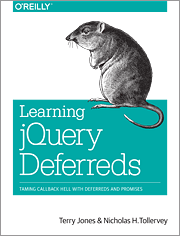 Nicholas Tollervey and I have written a book, Learning jQuery Deferreds, published by O’Reilly.
Nicholas Tollervey and I have written a book, Learning jQuery Deferreds, published by O’Reilly.
If you’ve been a reader of this blog over the years, you may have noticed that I’m very fond of deferreds (also known as promises or futures). I’ve mainly been using them in Python with Twisted, and a couple of years ago was happy to notice that jQuery also has a (somewhat different) version of deferreds. Asking around, it soon became clear that although there are tens of millions of programmers who’ve used jQuery, very few of them have ever used deferreds. E.g., at the jQuery conference in San Francisco in 2012, only about 25% of the audience in a talk on deferreds. There are about 19,000 results for “deferred” on StackOverflow.
This seemed like a perfect storm: a fantastically cool and empowering technology that I love thinking and writing about, built in to a ubiquitous web library, in use by millions of programmers, and yet somehow not widely known or used.
The book tries to really teach deferreds. There are 18 real-life examples, along with 75 challenges (and solutions). We’ve tried to get readers into deferreds the way we are, to be provocative, to try and get you thinking and scratching your head. To get you to see how cool and elegant working with deferreds can be. In short, to make you one of us.
Although the book focusses on jQuery’s flavor of deferreds, we wrote it with a much broader aim: to be just as useful to people working with any flavor of deferreds in any language. The concepts behind deferreds are few and simple. Even if you’re not a jQuery user or a JavaScript programmer, we hope you’ll enjoy and benefit from the book.
If you’re curious, the animal on the cover is a musky rat-kangaroo. O’Reilly chose it for us. When I first saw it, I mailed them and Nicholas to say it looked “overfed, passive, and thoughtful” to which Nicholas replied that it resembled me. The O’Reilly toolchain is modern and fun, employing AsciiDoc and a shared Git repo. We wrote 30,817 words and 2,301 lines of Javascript. There’s a source code repo for all the book examples, at https://github.com/jquery-deferreds/code. We spent six months on the book, during which I usually spent 1-2 days a week on it. It was a blast to write.
If you’d like to buy a copy, use AUTHD as a discount code on the O’Reilly site and you’ll receive 40% off the print or 50% off the e-book. Please let me know what you think, and/or leave a review on the O’Reilly (or Amazon) site. Have fun, and thanks!

